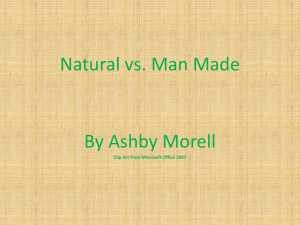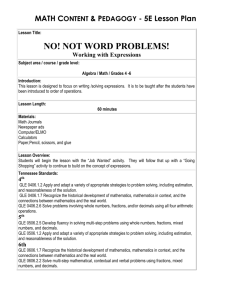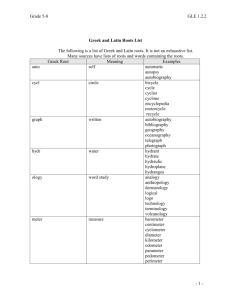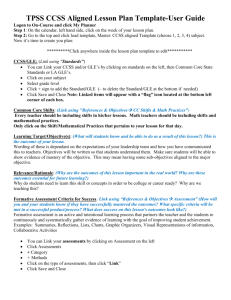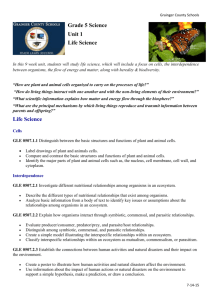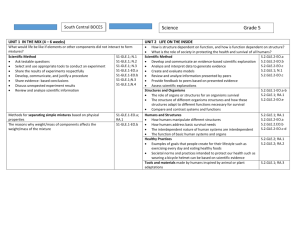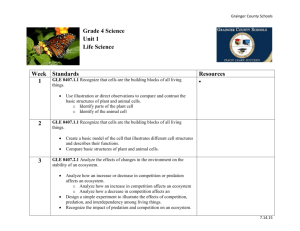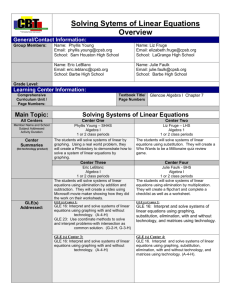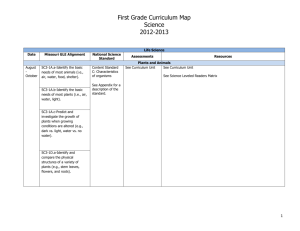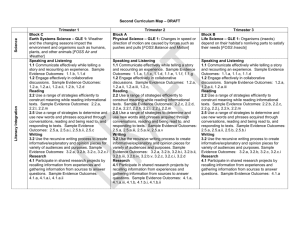Science 4 b&w
advertisement
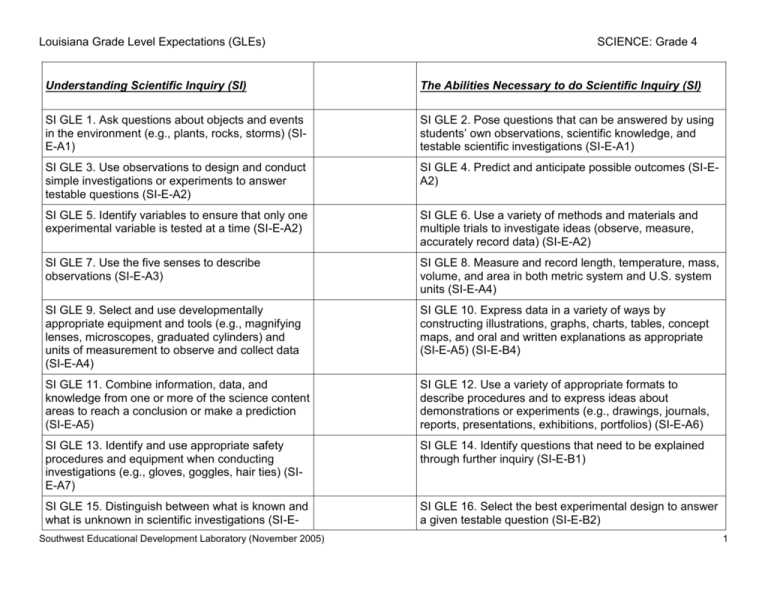
Louisiana Grade Level Expectations (GLEs) SCIENCE: Grade 4 Understanding Scientific Inquiry (SI) The Abilities Necessary to do Scientific Inquiry (SI) SI GLE 1. Ask questions about objects and events in the environment (e.g., plants, rocks, storms) (SIE-A1) SI GLE 2. Pose questions that can be answered by using students’ own observations, scientific knowledge, and testable scientific investigations (SI-E-A1) SI GLE 3. Use observations to design and conduct simple investigations or experiments to answer testable questions (SI-E-A2) SI GLE 4. Predict and anticipate possible outcomes (SI-EA2) SI GLE 5. Identify variables to ensure that only one experimental variable is tested at a time (SI-E-A2) SI GLE 6. Use a variety of methods and materials and multiple trials to investigate ideas (observe, measure, accurately record data) (SI-E-A2) SI GLE 7. Use the five senses to describe observations (SI-E-A3) SI GLE 8. Measure and record length, temperature, mass, volume, and area in both metric system and U.S. system units (SI-E-A4) SI GLE 9. Select and use developmentally appropriate equipment and tools (e.g., magnifying lenses, microscopes, graduated cylinders) and units of measurement to observe and collect data (SI-E-A4) SI GLE 10. Express data in a variety of ways by constructing illustrations, graphs, charts, tables, concept maps, and oral and written explanations as appropriate (SI-E-A5) (SI-E-B4) SI GLE 11. Combine information, data, and knowledge from one or more of the science content areas to reach a conclusion or make a prediction (SI-E-A5) SI GLE 12. Use a variety of appropriate formats to describe procedures and to express ideas about demonstrations or experiments (e.g., drawings, journals, reports, presentations, exhibitions, portfolios) (SI-E-A6) SI GLE 13. Identify and use appropriate safety procedures and equipment when conducting investigations (e.g., gloves, goggles, hair ties) (SIE-A7) SI GLE 14. Identify questions that need to be explained through further inquiry (SI-E-B1) SI GLE 15. Distinguish between what is known and what is unknown in scientific investigations (SI-E- SI GLE 16. Select the best experimental design to answer a given testable question (SI-E-B2) Southwest Educational Development Laboratory (November 2005) 1 B1) SI GLE 17. Recognize that a variety of tools can be used to examine objects at different degrees of magnification (e.g., hand lens, microscope) (SI-EB3) SI GLE 18. Base explanations and logical inferences on scientific knowledge, observations, and scientific evidence (SI-E-B4) SI GLE 19. Describe procedures and communicate data in a manner that allows others to understand and repeat an investigation or experiment (SI-EB5) SI GLE 20. Determine whether further investigations are needed to draw valid conclusions (SI-E-B6) SI GLE 21. Use evidence from previous investigations to ask additional questions and to initiate further explorations (SI-E-B6) SI GLE 22. Explain and give examples of how scientific discoveries have affected society (SI-E-B6) Southwest Educational Development Laboratory (November 2005) 2 Forms of Energy (PS) Position and Motion of Objects (PS) Properties of Objects and Materials (PS) PS GLE 23. Determine linear, volume, and weight/mass measurements by using both metric system and U.S. system units to compare the results (PS-E-A2) PS GLE 24. Illustrate how heating/cooling affects the motion of small particles in different phases of matter (PSE-A4) PS GLE 25. Describe various methods to separate mixtures (e.g., evaporation, condensation, filtration, magnetism) (PS-E-A5) PS GLE 26. Measure, record, and graph changes in position over time (e.g., speed of cars, ball rolling down inclined plane) (PS-E-B3) PS GLE 27. Describe how the amount of force needed to cause an object to change its motion depends on the mass of the object (PS-E-B4) PS GLE 28. Explain the relationship between volume (amplitude) of sound and energy required to produce the sound (PS-E-C1) PS GLE 29. Compare the rates at which sound travels through solids, liquids, and gases (PS-EC1) PS GLE 30. Explain the relationship between frequency (rate of vibration) and pitch (PS-E-C1) PS GLE 31. Diagram what happens to white light as it passes through a prism (PS-E-C2) PS GLE 32. Describe how light bends or refracts when traveling through various materials (e.g., pencil in a glass of water) (PS-E-C2) PS GLE 33. Describe how heat energy moves through a material by conduction (PS-E-C3) PS GLE 34. Give examples of ways heat can be generated through friction (e.g., rubbing hands) (PS-E-C3) PS GLE 35. Give examples of ways heat can be produced by conversion from other sources of energy (PS-E-C3) PS GLE 36. Test and classify materials as conductors and insulators of electricity (PS-E-C4) PS GLE 37. Demonstrate how a complete circuit is needed for conducting electricity (PS-E-C4) PS GLE 38. Explain the effects of Earth’s gravity on all objects at or near the surface of Earth (PS-E-C5) Southwest Educational Development Laboratory (November 2005) 3 PS GLE 39. Describe energy transformations (e.g., electricity to light, friction to heat) (PS-E-C6) Organisms and Their Environment (LS) Life Cycles of Organisms (LS) Characteristics of Organisms (LS) LS GLE 40. Explain the functions of plant structures in relation to their ability to make food through photosynthesis (e.g., roots, leaves, stems, flowers, seeds) (LS-E-A3) LS GLE 41. Describe how parts of animals’ bodies are related to their functions and survival (e.g., wings/flying, webbed feet/swimming) (LS-E-A3) LS GLE 42. Describe how the organs of the circulatory and respiratory systems function (LS-E-A5) LS GLE 43. Explain the primary role of carbohydrates, fats, and proteins in the body (LSE-A6) LS GLE 44. Analyze food labels to compare nutritional content of foods (e.g., amounts of carbohydrates, fats, proteins) (LS-E-A6) LS GLE 45. Identify reproductive structures in plants and describe the functions of each (LS-EB1) LS GLE 46. Describe how some plants can be grown from a plant part instead of a seed (LS-E-B1) LS GLE 47. Sequence stages in the life cycles of various organisms, including seed plants (LS-E-B1) LS GLE 48. Classify examples of plants and animals based on a variety of criteria (LS-E-B2) LS GLE 49. Compare similarities and differences between parents and offspring in plants and animals (LS-E-B3) LS GLE 50. Explain how some organisms in a given habitat compete for the same resources (LS-E-C1) LS GLE 51. Describe how organisms can modify their environment to meet their needs (e.g., beavers making dams) (LS-E-C1) LS GLE 52. Describe how some plants and animals have adapted to their habitats (LS-E-C2) LS GLE 53. Identify the habitat in which selected organisms would most likely live and explain how LS GLE 54. Describe the effect of sudden increases or decreases of one group of organisms upon other Southwest Educational Development Laboratory (November 2005) 4 specific structures help organisms to survive (LSE-C) organisms in the environment (LS-E-C3) Objects in the Sky (ESS) Properties of Earth Materials (ESS) ESS GLE 55. Recognize that sedimentary rocks are composed of particles that result from weathering and erosion (e.g., sandstones, conglomerates) (ESS-E-A1) ESS GLE 56. Investigate the properties of soil (e.g., color, texture, capacity to retain water, ability to support plant growth) (ESS-E-A1) ESS GLE 57. Explain how unequal heating of Earth’s land and water affects climate and weather by using a model (ESS-E-A2) ESS GLE 58. Draw, label, and explain the components of a water cycle (ESS-E-A3) ESS GLE 59. Measure, chart, and predict the weather using various instruments (e.g., thermometer, barometer, anemometer) (ESS-EA4) ESS GLE 60. Identify various types of weather-related natural hazards and effects (e.g., lightning, storms) (ESSE-A4) ESS GLE 61. Identify safety measures applicable to natural hazards (ESS-E-A4) ESS GLE 62. Classify rocks and minerals according to texture, color, luster, hardness, and effervescence (ESSE-A5) ESS GLE 63. Demonstrate and explain how Earth’s surface is changed as a result of slow and rapid processes (e.g., sand dunes, canyons, volcanoes, earthquakes) (ESS-E-A5) (ESS-E-A1) ESS GLE 64. Describe and sequence the phases of the Moon and eclipses (ESS-E-B2) ESS GLE 65. Compare a solar and a lunar eclipse (ESS-E-B2) ESS GLE 66. Diagram the movement of the Moon around Earth and the movement of Earth around the Sun (ESS-EB2) ESS GLE 67. Explain the changing appearance of the Moon and its location in the sky over the course of a month (ESS-E-B3) ESS GLE 68. Identify the relationship between Earth’s tilt and revolution and the seasons (ESS-E-B4) Southwest Educational Development Laboratory (November 2005) 5 ESS GLE 69. Explain how technology has improved our knowledge of the universe (e.g., Hubble telescope, space stations, lunar exploration) (ESS-E-B6) Science and the Environment (SE) SE GLE 71. Describe and explain food chains/webs and the directional flow of energy in various ecosystems (e.g., construct a model, drawing, diagram, graphic organizer) (SE-E-A2) Science and the Environment (SE) SE GLE 71. Describe and explain food chains/webs and the directional flow of energy in various ecosystems (e.g., construct a model, drawing, diagram, graphic organizer) (SE-E-A2) Science and the Environment (SE) SE GLE 71. Describe and explain food chains/webs and the directional flow of energy in various ecosystems (e.g., construct a model, drawing, diagram, graphic organizer) (SE-E-A2) Southwest Educational Development Laboratory (November 2005) SE GLE 70. Design an ecosystem that includes living (biotic) and nonliving (abiotic) components and illustrates interdependence (SE-E-A1) SE GLE 72. Predict and describe consequences of the removal of one component in a balanced ecosystem (e.g., consumer, herbivores, nonliving component) (SE-E-A2) SE GLE 70. Design an ecosystem that includes living (biotic) and nonliving (abiotic) components and illustrates interdependence (SE-E-A1) SE GLE 72. Predict and describe consequences of the removal of one component in a balanced ecosystem (e.g., consumer, herbivores, nonliving component) (SE-E-A2) SE GLE 70. Design an ecosystem that includes living (biotic) and nonliving (abiotic) components and illustrates interdependence (SE-E-A1) SE GLE 72. Predict and describe consequences of the removal of one component in a balanced ecosystem (e.g., consumer, herbivores, nonliving component) (SE-E-A2) 6
